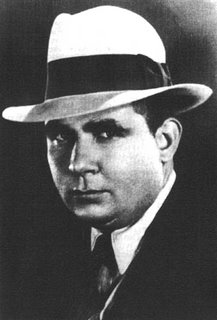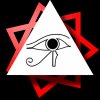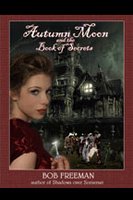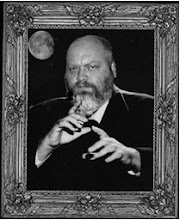What follows is 90% rubbish, intermixed with a dash of truth... certainly it is slanted against the Master Therion. As dispicable as the article is, knowing Crowley, he would have relished in the bad press...From the Daily Mail
(Friday, January 6, 2006)
by Glenys Roberts
The workmen demolishing one of central London's Victorian buildings were edging their way along the dark corridor. Above them was the familiar rumble of Christmas rush-hour traffic, but down below where they were working, the crumbling brick vault was suddenly lit up by an eerie light. Nervously, they'd peered into the dim void -- only to see something so sinister and unexpected that even their foreman, a civil engineer, turned ghastly white. For among the rubble was a human skull illuminated by a flickering candle — and beside it, a pile of twigs arranged in the shape of a pentacle, the five-pointed star that is the ancient and powerful symbol of witchcraft. This bizarre incident took place recently in the capital's legal district, an area usually associated with cold reason and logic. Unbeknown to the men working on site, they were demolishing a building which had once been home to a coven led by the notorious Aleister Crowley, known as the Beast 666, the Devil's Disciple.
Crowley was one of the most infamous figures of the 20th century. Said to have been born with the sign of the swastika on his chest, he became a notorious satanist who claimed he could commune with the devil in drug-induced trances. He went on to found a polygamous religion indulging in animal sacrifices and sexual abuse, and was so promiscuous and uncaring that at least five of his many mistresses committed suicide. His best-known exploits took place in the 1930s in Sicily where he founded an 'abbey' dedicated to the devil. However, connoisseurs of his evil reputation know that there are sites in Britain associated with the so-called wickedest man on earth. Most famous is Boleskine House on Loch Ness where Crowley lived at the end of the 19th century. But few people realise that Crowley was also associated with the office building in London's Chancery Lane, which is being redeveloped into modern flats, shops and offices. Indeed, until the bulldozers moved in, the four-storey block which is part of the Earl of Radnor's estate, had a prestigious reputation, inhabited as it was at street level by a number of friendly boutiques including Thresher and Glenny, the Queen's shirtmaker who have held a Royal patent since 1783. Up above, there were offices. But there were also residential flats, one of which was the home of the young Crowley when he first came down from Cambridge in 1898.
In fact it was in this flat, where according to visitors an intense atmosphere of evil prevailed, that his sinister interest in the occult first gelled. So were the mysterious skull, candle and pentagram that appeared in the vaults recently arranged there in some act of misplaced homage? Could it really be true that there are still those today who follow his dark rituals and who are drawn to this site as an act of satanic pilgrimage? Could there perhaps be some malign paranormal force etched into the building's very fabric?
Born in Leamington in 1875 to a wealthy brewing family who were Plymouth Brethren, the future satanist was named Edward after the father he came to adore. But Edward senior died of cancer when the youngster was 11, an experience so traumatic that Crowley lost all interest in the family's religion. The boy hated his pious mother who sent him to a series of public schools, including Malvern where he was mercilessly bullied because he was fat. Having persuaded her to remove him by claiming he was being sexually abused, he was given a home tutor who, despite being a former Bible Society missionary, introduced him to such worldly pursuits as billiards, betting and cards. When he took Crowley to Torquay, the boy lost his virginity at the age of 15 to a young actress. And when his horrified mother learned of this she labeled him the 'Beast'.
In 1895, Crowley, by now calling himself Aleister because of its Celtic overtones, went to Cambridge University to read moral sciences. Instead of studying, however, he boasted he spent his time on sexual experimentation. Leaving three years later without a degree, he used his considerable family inheritance to take a flat in the neo-classical building in London currently being excavated, signing the lease with one of the many aliases he loved to use -- Count Vladimir Svaroff. The flat in Chancery Lane with its long corridors in an area of London full of medieval resonances, was perfect for the budding satanist who was fast making it his mission to dispel Victorian hypocrisy by any means he could. Crowley had just been introduced to the Hermetic Order of the Golden Dawn, a mysterious masonic society which claimed to possess arcane truths handed down to the modern world from ancient Egypt. He soon became an initiate, taking the name of Brother Perturabo, meaning: 'I will endure'. But Crowley rapidly came to despise his fellow brethren - who included the Irish poet W B Yeats - because of their timid approach to magic. Determined to conduct bolder experiments into the supernatural, he took his as his personal instructor an impoverished magician called Alan Bennett whom he invited to stay with him. And so a period of intense magical activity began, based on the invocations of a medieval German magician, called Abramelin. Crowley and his followers believed that they could summon the spirits of the dead, through animal sacrifice and pagan rituals. Piecing together Crowley's writings and those of the impressionable acolytes that visited the place Crowley's day, we have a good idea what the flat looked like, not to mention the sinister things that went on inside.
The visitor passed from the cold stone dusk of the stairs to a palace of rose and gold that has long since vanished. Gold-black Japanese wallpaper covered the rooms and the place was lit like a brothel by an ancient silver lamp with a red bulb. The floor was covered with leopard skins and on the wall there was a huge crucifix in ivory and ebony. There were two temples, one to good, the other to evil. In Crowley's 'Black Temple', actually more of a cupboard, a blood-stained skeleton sat before an evil altar, made of a round table supported by the figure of an ebony negro standing on his hands. On the altar a sickening perfume smouldered in a container and one visitor claimed the stench of previous blood sacrifices filled the air. In his delusions Crowley used to feed the skeleton blood, small birds and beef tea in the hope of reviving it.
No wonder people were afraid of him.
It was said that in the streets horses reared at his approach and that he was imbued with so much magical power that his coat once burst into flames. In order to create real magic, Crowley believed he needed the use of a large remote country house with a terrace at the door facing north, the best direction in which to create a spell. In Boleskine, in northern Scotland, he found the perfect house in the perfect spot. He fell in love with it and having inherited nearly £5 million pounds in today's money immediately bought it. There he claimed he invoked at least 100 spirits. But he soon parted company with the rest of the followers who wanted to use magic for good rather than evil.
Yet still he had not reached the depths of his malign life. That began on a visit to Paris in 1903 when the 28-year-old magician looked up his old university friend, the portrait painter Gerald Kelly, and within a short time had married Kelly's widowed sister, Rose. The couple embarked on a lengthy honeymoon to the Far East and soon Rose was pregnant. But the happiness was short-lived. Crowley hated women so much that he used to say that they should be brought round to the back door like the milk deliveries, and he was soon given to regularly stringing his naked wife up in the cupboard. History does not relate how or why - but it was probably due to a combination of his misogyny, sadism and belief in black magic. Still honing his evil persona, he now claimed to have had a vision of himself as the new Messiah, saying he had received a message from an angel called Aiwass who told him he was the herald of a cult which would have its own Bible, the Book Of Thelema, the Greek word for will. He set to writing it with gusto, taking degeneracy as his creed and filing his teeth to sharp points to give himself a horrifying appearance. And he replaced the Ten Commandments with just one: "Do what you want, is the whole of the law'.
Worse was to come.
A keen mountaineer since boyhood, in 1905 Crowley set out to climb Kangchenjunga, a peak which, according to Nepalese legend, is the home of the gods. It was an ill-fated mission during which he beat one of his servants to death. And when another slipped and caused an avalance, he refused to help dig out his comrades, all of whom perished. After the tragedy he declared he wanted no more 'Christianity, rationalism, Buddhism, the lumber of the centuries ... I want blasphemy, murder, rape, revolution'. Seemingly overnight, the odious Crowley abandoned Rose, along with his little daughter, whom he had named, with his usual flamboyance, Nuit Ma Ahathoor Hecate Sappho Jezebel Lilith.`I was no longer influenced by love for them, no longer interested in protecting them as I had been,' he wrote.
Though he made wild claims about his determination to give free rein to his insatiable sexual energy, Crowley was, in reality, a pathetic figure interested primarily in fame at any price. Back in London he tried putting on dimly-lit public displays of heathen rites in which a male disciple, rumoured to be his lover, performed an erotic dance while his new Australian mistress played the fiddle. The advance publicity suggested unspeakable sex acts, but there were none. At the end of the performance, Crowley shouted: `There is no God,' hoping to get arrested under the blasphemy laws, but no one was interested. His next adventure was a trip to Europe with several lady friends, smoking hashish, drinking alcohol and using opium. Then, as World War I was declared, he fled to the U.S. where he gave an infamous pro-German speech at the base of the Statue of Liberty.
By the time he returned to Britain in 1919, he was broke, having spent the last of his family money. In failing health, Crowley turned to heroin. He was just 44, his only source of income was a publisher's advance of £60 (about £2,000 these days) for a novel about drugs, his only survival strategy to find a poverty-stricken part of Europe where he could practise his foul ideas on the cheap. That is when Crowley decamped to Sicily, where the cost of living was dirt cheap, and he would pass his most infamous years. With his new American mistress Leah Hirsig, a new baby daughter and her nurse who had a child of her own, he set up home in a primitive hilltop villa which he named 'the Abbey of Thelema' and dedicated it to his self-indulgent cult. Dogs and children ran round a yard littered with all the paraphernalia of drug-taking and the black arts. Here Crowley's half-starved children were made to witness sexual debaucheries, including the ritual violation of his mistress by a goat on the instructions, so he claimed, of one of his guiding spirits, the Secret Chiefs. When one of his visitors died after drinking cat's blood in a black magic ceremony, his evil reputation was assured.
Crowley was now a universal figure of hate. Chased out of Italy and dubbed the man we would most like to hang', he fled to North Africa, sleeping with young boys and prostitutes in every city he visited.His behaviour was increasingly bizarre. When he was introduced to a woman he would grab her wrist and bite it until it bled. Yet, even though he was fat and bald with fetid breath, women were still bowled over by his mesmeric stare.
Crowley was to marry once again in 1929, this time in Leipzig, to a middle-aged Nicaraguan. A year later he took up with a new 19 year-old German mistress, who subsequently committed suicide. He spent his last years in Britain in and out of court, instigating libel actions, calling himself by dozens of grandiose aliases. After a minor heart attack he moved to a seedy boarding house in Hastings. There he died in 1947, aged 72, not in any satanic ritual, but alone in bed, tears streaming down his cheeks. His last words were: 'I am perplexed. Sometimes I hate myself.'
But Crowley was not finished yet. At his cremation in Brighton, a satanic ritual invoking the great god Pan was performed by his bohemian followers. Afterwards his ashes were whisked away to America by adherents of his new religion, Crowleyism. His influence has never died out. The Beatles included him on their Sergeant Pepper album cover as one of the iconic faces of the 20th century. And when American sexologist Alfred Kinsey visited his Sicilian abbey to explore Crowley's ideas about free love, the desperate satanist finally received a lasting accolade as father of the permissive society. And it had all begun in that flat in Chancery Lane.
Today the building is a gutted shell. Gone is the pungent incense, the Victorian hangings and the evil altar. But who placed the magical trappings on the spot where Crowley once honed his craft?The pentagram is the satanic symbol of the Black Goat Baphomet, which was Crowley's magical name. It is still used today by Neo Pagans. The builders who stumbled on the sinister display knew nothing of this. They maintain it was planted there by a casual labourer who must have known that Crowley had once lived there. They say they are treating the whole thing as a joke. Yet, whether to protect the developers' interests or themselves from evil repercussions, there is some evidence they are taking it more seriously than they admit. The workman suspected of planting the portents is no longer welcome on site. Yet his departure has made no difference to the gloomy atmosphere of the building. Neither has it erased the tangible nervousness of the men who remain working there who sometimes still turn up in the mornings to find guttering candles in the dark corners.
They cannot escape the nagging fear that they might have disturbed the evil soul of its ghoulish former tenant.
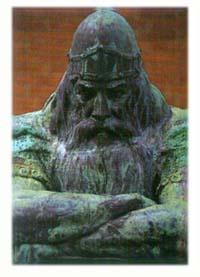 I just received this urgent message from Steve McNallen:
I just received this urgent message from Steve McNallen: